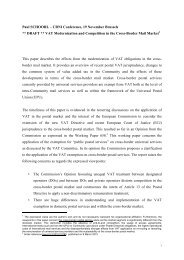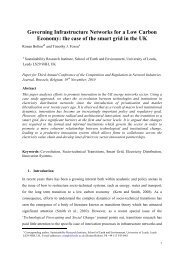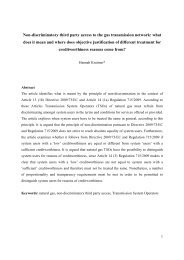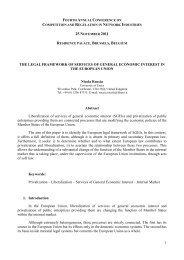Regulatory Incentives for Investments in Electricity Networks - CRNI ...
Regulatory Incentives for Investments in Electricity Networks - CRNI ...
Regulatory Incentives for Investments in Electricity Networks - CRNI ...
Create successful ePaper yourself
Turn your PDF publications into a flip-book with our unique Google optimized e-Paper software.
Drivers" that will adjust the revenue restriction depend<strong>in</strong>g on whether there are significant<br />
unexpected changes to the level of generation connect<strong>in</strong>g <strong>in</strong> different parts of the system. This<br />
uses a system of "Unit Cost Allowances" (UCA) that will provide £m (million pounds) <strong>for</strong><br />
<strong>in</strong>cremental capacity changes of "Y" MW. The UCA is set with reference to the likely level of<br />
<strong>in</strong>vestment needed reflect<strong>in</strong>g the balance of generation and demand <strong>in</strong> the zone.<br />
5.2 Quality Incentive Schemes<br />
Capital costs generally <strong>for</strong>m a substantial part of the firm’s total costs and <strong>in</strong>vestment decisions<br />
have a significant impact on the network’s quality. Assur<strong>in</strong>g that <strong>in</strong>vestments are undertaken at<br />
least costs and deliver an adequate quality level can generate significant benefits to society. The<br />
ability to effectively measure the per<strong>for</strong>mance of <strong>in</strong>vestment proposals <strong>for</strong> both price and quality<br />
is there<strong>for</strong>e an important regulatory task.<br />
Regulators have developed different methods to encourage quality of supply. The traditional<br />
method is based on quality per<strong>for</strong>mance standards. Standards put a floor on the per<strong>for</strong>mance<br />
level of the company measured by selected quality <strong>in</strong>dicators. Violation of the standard can lead<br />
to a f<strong>in</strong>e or tariff rebate. Examples of such quality per<strong>for</strong>mance standards refer to customer<br />
m<strong>in</strong>utes lost, percentage of customers with an outage, response to customer requests and<br />
compla<strong>in</strong>ts.<br />
Quality <strong>in</strong>centive schemes can be considered an extension of a quality per<strong>for</strong>mance standard.<br />
Alternatively, a standard can be considered as a special case of a quality <strong>in</strong>centive scheme.<br />
Under quality <strong>in</strong>centive schemes the company’s per<strong>for</strong>mance is compared to some target def<strong>in</strong>ed<br />
<strong>for</strong> a certa<strong>in</strong> quality <strong>in</strong>dicator (e.g. reliability measured by SAIDI or energy not supplied) or a<br />
comb<strong>in</strong>ation of <strong>in</strong>dicators. Deviations from the target result <strong>in</strong> either a penalty or a reward.<br />
5.3 Cost of Capital<br />
Regulated service providers compete <strong>for</strong> f<strong>in</strong>ance with companies operat<strong>in</strong>g <strong>in</strong> competitive<br />
markets and thus rely on the same f<strong>in</strong>ancial market conditions. Equity and debt f<strong>in</strong>ance will only<br />
be available to utilities who agree to credit conditions posed to firms that operate <strong>in</strong> competitive<br />
<strong>in</strong>dustries and have a comparable credit rank<strong>in</strong>g. Equity f<strong>in</strong>ance will only be available if<br />
profitability can be expected that covers the risk free rate of <strong>in</strong>terest (i.e. yield of long term<br />
credible government bonds) and a risk premium.<br />
Given the capital-<strong>in</strong>tensive nature of electricity networks, the return on asset accounts a<br />
significant share of the allowed revenue. As relatively small changes to the rate of return can<br />
have a significant impact on the total revenue requirement and <strong>in</strong>vestment behaviour of the<br />
companies, it is essential that the regulator sets the rate of return at a level that reflects an<br />
adequate commercial return <strong>for</strong> the regulated companies. The Weighted Average Cost of Capital<br />
(WACC) is a commonly used method <strong>for</strong> determ<strong>in</strong><strong>in</strong>g a return on an asset base. It is generally set<br />
equal to the sum of the cost of each <strong>in</strong>dividual component of the capital structure weighted by its<br />
share. 19<br />
19 The WACC calculation will look different depend<strong>in</strong>g on how taxes are treated <strong>in</strong> the revenue requirements. A<br />
post-tax WACC is def<strong>in</strong>ed as the average rate of return needed to provide an appropriate return to <strong>in</strong>vestors <strong>in</strong> the<br />
14







